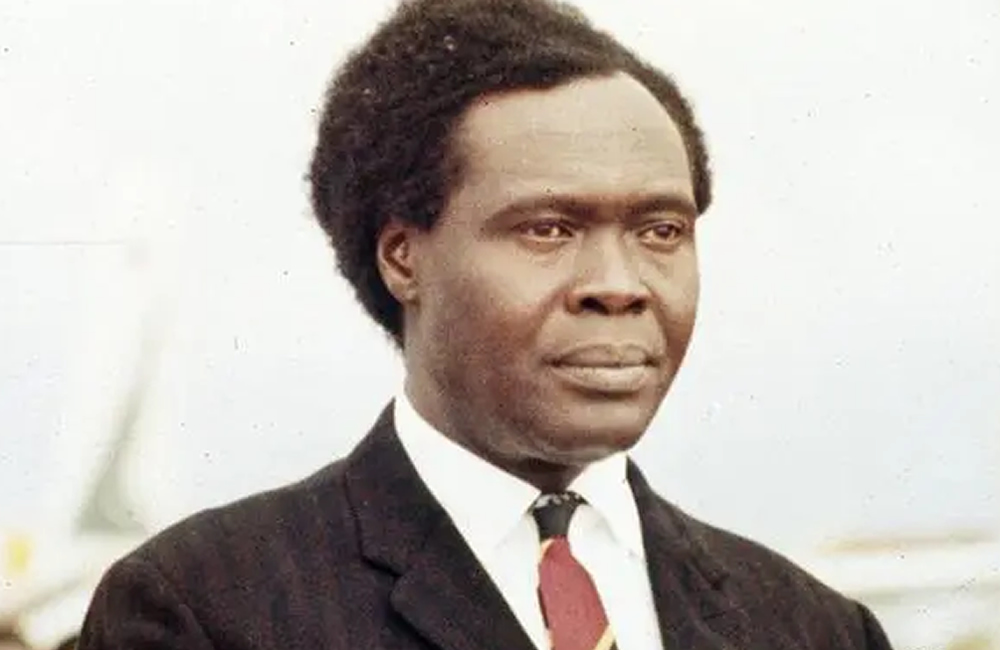
Obote and Uganda’s Independence
” At the turning-point in the history of Uganda, I hope that all our friends will join with me in bestowing upon the new, independent Uganda our prayers and hopes for peace, prosperity and a growing strength in her now role in international affairs. Uganda has many friends, both within her borders and outside. With the goodwill of all who wish to see her prosper, Uganda will go forward from strength to strength.
Let us pause for a moment and look back along the path we have traveled. In the days before this part of the African continent was known to the western world, we became known as a group of peoples who welcomed the traveler, the missionary and the explorer. As the years passed, we reaped the benefit of this friendly nature of ours. The technical progress of the last half-century has transformed our country in countless ways. But, fortunately, we have continued to keep our own customs and culture. It is up to us now, more than ever, in shaping our new country, to achieve a consolidation, in which neither the rapid progress of recent years, nor the age-old customs of our forefathers, are lost or diminished, but rather fused into a new national characteristic in which the best is preserved, while the worst may be thrown away.
AN UHURU MESSAGE FROM THE PREMIER
from the Uganda Argus
National unity
What other aims have we, today, on looking forward? One of our first needs must be national unity. The narrow ambitions of a tribe, a sect, or a party must be subordinated to the greater needs of one complete Uganda.
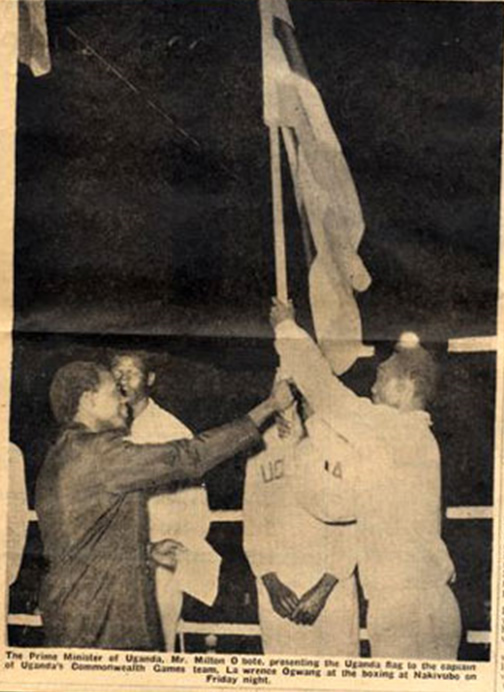 In our Government of these past months, we have striven to put the interests of Uganda before all else, and we shall continue to do so. But on attaining independence, this Government has new responsibilities to bear, heavier than those which any previous government in Uganda has borne, and we are conscious of the care and statesmanship with which we must move in taking our first steps in foreign affairs. In the Commonwealth and in the United Nations we shall be among friendly states, both from other parts of Africa and from elsewhere. But the regard in which a nation is held in the eyes of the world depends upon the successful operation of a complex machinery.
In our Government of these past months, we have striven to put the interests of Uganda before all else, and we shall continue to do so. But on attaining independence, this Government has new responsibilities to bear, heavier than those which any previous government in Uganda has borne, and we are conscious of the care and statesmanship with which we must move in taking our first steps in foreign affairs. In the Commonwealth and in the United Nations we shall be among friendly states, both from other parts of Africa and from elsewhere. But the regard in which a nation is held in the eyes of the world depends upon the successful operation of a complex machinery.
On 9th October, 1962, Uganda becomes an independent sovereign state within the Commonwealth of Nations. H.M. the Queen becomes Queen of Uganda and the Head of State, represented in Uganda by a Governor-General.
Her Majesty is to be represented at the celebrations by H.R.H. the Duke of Kent and the Duchess of Kent who will afterwards make a tour of the Regions.
from the Uganda Independence Souvenir Programme.
We have paid attention to the design of that machinery. First, we require political stability. My Government will seek to maintain that stability, by the strict maintenance of law and order, by retaining the confidence of the voters, and by upholding the freedom of the individual. Secondly, we require to safeguard the economy. This we will do by diversifying and improving our agriculture, providing incentives to industry, and creating conditions which encourage foreign investment. Thirdly, we will press forward with social services within realistic bounds and not as dictated by idealism. Fourthly, we need an efficient civil service to operate the Government. Uganda is well provided with well-qualified African officers and we shall continue to ensure that these are attracted into government service by the offer of the right terms, so that a balanced Africanisation programme shall continue.
I conclude by emphasising that there is a place in the Uganda of today for all who have her interests at heart, whatever their tribe, race or creed. Let all of us, who wish to see Uganda prosper, join together today in resolving to build a great and united nation.”
Read More
The Mountain Gorilla Highlands
Uganda’s Gorilla Highlands stretch from Kabale area, Kisoro, Bwindi Impenetrable Forest, Mgahinga National Park to Kanungu area conveying most of Uganda’s beautiful scenic views.
Uganda is a haven for many natural attractions like the lakes from where one can enjoy the wonderful sights and sounds of various bird species such as Lake Bunyonyi, Lake Kayumbu and Lake Chahafi, Lake Mutanda and Lake Mulehe. It’s also park for mountain gorillas found in Bwindi Impenetrable National Park. It’s also a home to many primate species like the chimpanzees, golden monkeys which can all be tracked with the help of a well-trained tour guide.
Recently-developed trails offer some of East Africa’s most spectacular hikes across rural Africa, safe to explore per pedes apostolorum, by dugout canoe across the lakes or by mountain bike cross country.
Only a few parts of Uganda have been documented with trail descriptions, maps, and video maps, the latest tool available for wannabe visitors to this part of Uganda. Accommodation is now available from basic camping over home stays to luxurious lodges.
According to Miha, the head behind the gorilla highland project “The Gorilla Highlands initiative” was started in 2011 by Edirisa, a social enterprise based at Lake Bunyonyi. It is open to anybody interested in branding and promoting southwestern Uganda for the sake of rural development. It has established the ‘Gorilla Highlands’ brand as a flag to unify the region, connect local companies of all sizes into a network, and expand tourist expectations of what the area can offer. We are focused on innovative solutions to tell the world an engaging story about our part of Africa. The Gorilla Highlands initiative offer travelers, tour operators, the media, and development organizations a centralized and consistent service built on extensive local knowledge.”
He further noted, “We are tapping into a world-class web of professionals passionate about this region whose very first product, the Gorilla Highlands Interactive eBook, won a United Nations award in 2013. While the eBook showcases our deep knowledge of our home area, Gorilla Highlands is much more than that. We are about rural development empowered by culture. Our belief is that economic transformation in southwestern Uganda is only possible when we have respect for our cultural heritage, and when we properly utilize tourism as a tool to uplift the poor.”
In his notes, Miha Logar stated that “Our current biggest project is the Gorilla Highlands Video Map. It challenges tourists’ potentially negative preconceptions by giving video tours of places, lodges, and activities, revealing beautiful, comfortable, and safe environments. On the other hand, we don’t just do multimedia products. We tell our story of southwestern Uganda through tourism experiences as well – Gorilla Highlands Trails is a system of guided trips, taking from 5 hours to a week or more, including camping with rural families and with a special stress on the Batwa.
“Our tour itineraries already utilize Kigali as the airport hub; expansion of the Gorilla Highlands concept into Rwanda is planned for 2015.”
By using Kigali as the entrance airport helps to lessen / cut short the distance covered to reach the south western part of Uganda. It is also suggested to use due to the existence of the common tourist visa that entails visitors easy passage through Uganda, Rwanda and Kenya and it can be obtained at 100 USD.
In addition, this gives tourists a chance to enjoy the beautiful sights of “Land of a Thousand Hills” before crossing over to Kisoro / Katuna and Kabale via Cyanika border for the amazing spotlights of the South Western part of Uganda.
Uganda is now connected to the rest of the world by the top African, European, and Gulf /*8airlines daily and apparently known among Africa’s number one adventurous destinations since it’s a peaceful and Ebola Free State.
Gorilla Highlands offers pocket guides and last year launched the award winning e-book available from the Apple Store.
Read MoreUganda: Gorilla Tourism Spurs Growth in Kigezi Region
Mountain gorilla tourism has not only contributed huge sums of money to the national economy, it has immensely sparked development in the Kigezi sub-region.
More than 18,000 gorilla permits are sold annually, which translates into an annual collection of more Shs38b. Each permit costs Shs2.16m ($600). According to John Justice Tibesigwa, the Bwindi and Mgahinga National Park acting conservation area manager, mountain gorilla tourism started in 1961 when the area was still a sanctuary.
In 1991, it was strengthened and was later, in 1994, recognised as a heritage site.
Tourism, Tibesigwa says, has not only benefited government but enabled Uganda Wildlife Authority to contribute Shs900m annually to communities around Bwindi-Mgahinga for development projects.
The Bwindi-Mgahinga area has more than 14 gorilla groups and only eight tourists are allowed to visit a gorilla group per day.
Available data indicate that the Bwindi-Mgahinga area has half the world’s population of mountain gorilla.
This, as a result, has attracted tourists in the area and has had a spillover effect in terms of service development, especially in hotel and hospitality and the transport sector.
Source of employment
More than 100 hotels and camp sites have been established and provide employment to more than 10,000 people.
Hotels such as Accadia Cottages, Bunyonyi Overland Resort Camp, Entusi, Bushara and Sharp Island Gorilla Lodge, among others are a good addition to the Kigezi tourism.
In the transport sector, an airstrip has been established in Kihiihi, Kanungu District and another is under construction in Rubanda District. The two will be an addition to the already existing Kisoro Airfield.
“Tarmacking Kabale- Kisoro road has also facilitated development. However, government should improve internet connectivity, provide electricity, especially in the national parks,�? Ivan Mbabazi Batuma, a member of the Kigezi Tourism Cluster, says.
Other tourism features such as Lake Bunyonyi, Mt Muhavura, and Queen Elizabeth National Park, Batuma says, should be promoted to create alternatives as well as establishing a special desk at border points to handle tourists.
Nicholas Byengoma, the vice chairperson of the Kigezi Tourism Cluster, says whereas government has injected money into the tourism sector, more needs to be done.
“Encourage the establishment of domestic air transport to ease movement, especially for tourists visiting different destinations, he says.
Tourism, as already stated, employs more than 10,000 people in the Kigezi sub-region and this, according to Seith Byarugaba, an investor in accommodation, is a big achievement that government should leverage on.
“There is need to habituate other animal species such as chimpanzees, red monkey and birds to diversify, he says.
Government, Fideli Kanyamunyu, the director of Wagtail Tourism Investments in Kisoro District, believes should return much more to local communities instead of the current 20 per cent.
“… giving us only 20 per cent of the entrance fees, which is only $40 out of the $600 should be revised, he says and appeals to government to consider giving soft loans to community members to improve the quality of their products.
But beyond looking at government, Akankwasa Barirega, the acting commissioner for Wildlife Conservation at the Ministry of Tourism, advises local communities and members in the Kigezi Tourism Cluster to be more innovative, especially in regard to creating tourism amenities.
For instance, he says, people should think of establishing facilities such house boats on Lake Bunyonyi, zip lines crossing the interlocking hills, cable cars on Mt Muhavura and hot air balloons, among others.
“You earn a lot because there is a ready market [tourists], he says.
Silver Baguma, the vice chairperson of Rubanda District, thinks that stakeholders meetings such as the one held recently, provide good engagement.
However, he argues, for employment opportunities, residents must be considered as the first priority.
Read MoreKarimojong Warrior Dancers Wow Uganda Martyrs’ Pilgrims
This year’s annual martyrs celebrations on 3rd June were led by Bishop Giussepe Filippi of Kotido located North Eastern Uganda. He was accompanied by the diocesan choir and a troupe of Karimojong warriors donned in traditional garb in a gallantry of hymn, dance and worship to the delight of Pilgrims.
This year attendance hit the one million mark with President Yoweri Museveni being the chief Pilgrim. Also in attendance was Maria Nyerere widow of the founding Father of The Republic of Tanzania, Mwalimu Julius Kambarage Nyerere.
The President committed government support to the development of the martyrs’ shrines into tourism attractions. This will add impetus to efforts by the Uganda Tourism Board in promoting religious tourism that began with a martyr’s charity walk dubbed ‘in the Footsteps of The Uganda Martyrs the previous day.
Pilgrims came from as far as Malawi, Democratic Republic of Congo, Rwanda,Kenya, the United States of America and Nigeria.
Over 45 martyrs were burnt alive in 1886 on the orders of the reigning Kabaka (king) of Buganda following growing dissent in the kings court from the new converts to Christianity at the height of colonial struggle.
Festivities will be held in the same venue on the 18th October to commemorate Golden Jubilee since the canonization of the Catholic martyrs by Pope Paul VI.This shall coincide with the commemoration of the martyrdom of lesser known martyrs Jildo Irwa and Daudi Okello from Acholiland in Northern Uganda who were martyred almost 25 years later in Paimol.
Read MoreUganda Discounts Gorilla Permits
The management of Uganda Wildlife Authority (UWA) has launched a Gorilla tracking promotion to enable potential visitors enjoy the same gorilla experience at subsidized rates. According to a statement from the Executive Director, Dr. Andrew Seguya, the following promotional prices will apply for visitors wishing to track gorillas within the months April and May 2015.
Foreign Non Residents will pay US $ 350 for a permit instead of US$600, Foreign Residents US$300 instead of US $500 and East Africans will part with UGX150,000 instead of UGX250,000.
Dr. Seguya says in a statement that the promotion is aimed at giving back to UWA’s esteemed customers. The promotion which is open to all tour operators and partners will be guided by the following guidelines. The promotional period will run for the months of April and May 2015.
This applies to unsold permits for this period and does not include prepayments before announcement of this promotion.
Payment for all gorilla permits under the promotional rates shall only be done at the Reservations office at UWA Headquarters in Kampala only. No promotional permits will be sold at the park .Permits offered for sale under these promotional arrangements will be paid for in full (100% of value) at the time of booking. The acceptable payment methods are cash or direct bank transfers. There will be no cash refunds, reschedules, cancellations and transfers allowed on promotion permits. Promotional permits will be marked “”Promotional Permit””
Uganda is a home to more than half of the world’s population of mountain gorillas.Bwindi Impenetrable National Park and Mgahinga Gorilla National Park in South western Uganda are host to the mountain gorillas which live in organised social groups.
For further information and to reserver your permit please call reservations on +256 414355 403 or email reservations@ugandawildlife.org
Read More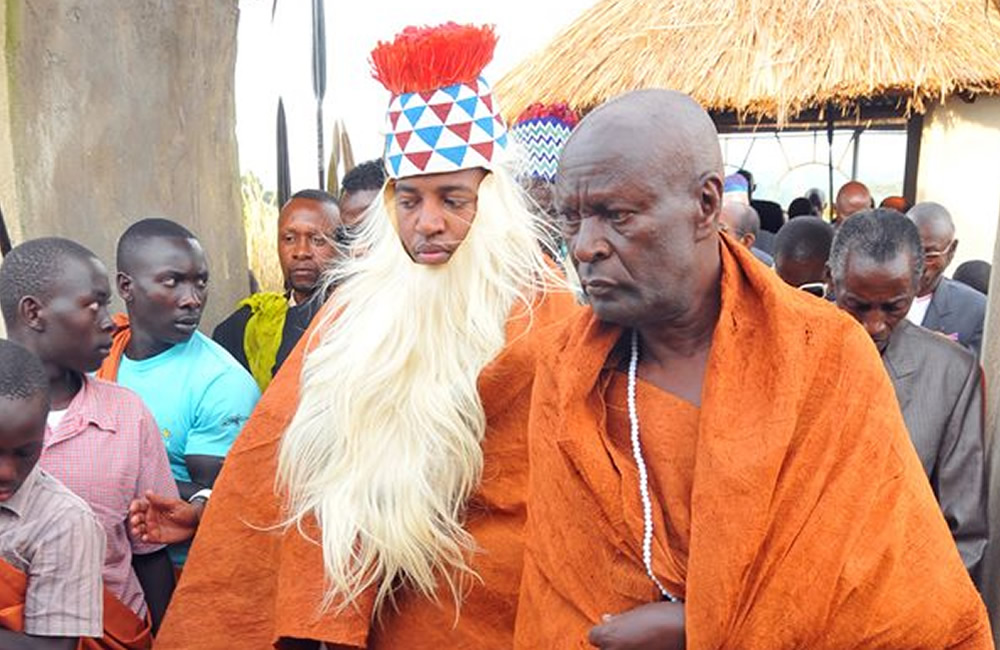
Tooro Marks 18th Coronation Anniversary Tomorrow
Tooro Kingdom will September 7 (Saturday) mark its 18th coronation anniversary. King Oyo Nyimba Kabamba Iguru Rukidi ascended to the throne in 1995, following the death of his father, Patrick Olimi Kaboyo to become the 12th ruler of the 180-year-old kingdom.
The celebrations are scheduled to take place at the royal palace in Fort Portal, Kabarole District, will be graced by President Yoweri Museveni and other dignitaries from abroad.
The kingdom of Toro, of the babiito dynasty, aptly claims its rightful origins in the ancient empire of Kitara. The first son of Omukama Kyebambe III of Bunyoro rebelled and annexed the southern part of his father’s kingdom, forming his own kingdom.
He placed the northern border of his new kingdom at River Muziizi. The kingdom of Toro was born, under the reign of Rukirabasaija Omukama Kaboyo Kasunsunkwanzi Olimi I.
Following the death of Omukama Kaboyo Olimi I, there followed several other kings and princes on the Toro throne. Some of them reigned for very short periods of time, during which they were still referred to as “Omubiito” (prince) , not by the right title of “Rukirabasaija Omukama”. When we include such princes, the number of batooro kings comes to 8.
The present Omukama is Rukirabasaija Omukama Oyo Nyimba Kabamba Iguru Rukidi IV. A brief write up on each Omukama follows. It should be noted here that the numerical denotation of kings of Toro takes off from the list of Bunyoro kings, before Toro broke away. This is why, for instance, while there have been a total of two kings with the name Olimi on the Toro throne, Omukama Patrick Matthew Kaboyo Olimi was Olimi VII.
Read More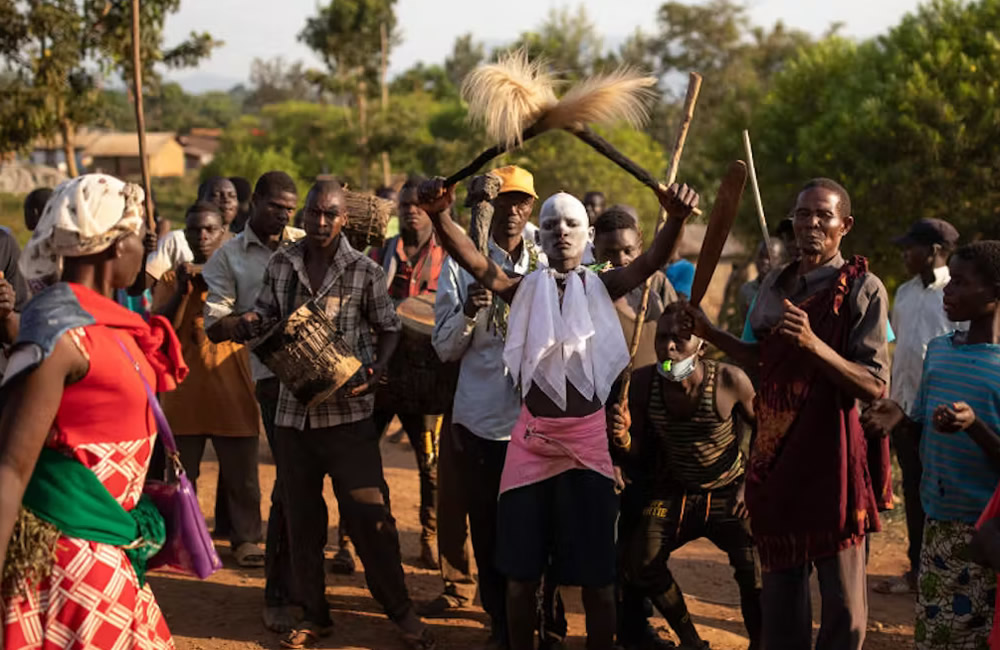
Bamasaaba Launch 2012 Circumcision Season
Traditional Circumcision Ceremony or Imbalu season opens in Uganda
The Bagisu “Gisu” tribe in Eastern Uganda launched the start of this year’s cultural circumcision season on Friday commonly known as ‘Kushina Imbalu’.
The opening ceremony of this year’s 2018 Imbalu season-an ancient Ugandan practice of mass teenage circumcision, was officiated by the Bamasaaba cultural leader Omukuuka Wilson Wamimbi who warned against forceful circumcision – according to www.westfm.co.ke
While speaking at the launch held at Bungokho Mutoto Sub County in Mbale District, the Wamimbi sounded a serious warning against those involved in forceful circumcision saying that the act has brought fear among the non Bagisu ling in the area leading to under development in Bugisu land.
He said that those involved in the act are not true Bamasaaba adding that they might be rebels or Al Shabab using the opportunity to tarnish the name of the kingdom but has however called upon the Government and other stakeholders to help in curbing the threats.
The ritual held around August of every even numbered year is Uganda’s largest mass circumcision.The ceremony signify the rituals, musics and dances performed to initiate adolescent boys into manhood among the Bagisu. Often a public event, it is a celebrated and widely practiced Gishu tradition.
The Bagisu (singular Mugisu) are people of the Bantu family who live along the slopes of Mount Elgon (also called Mount Masaba) in eastern Uganda
For further reading or to learn more about the Imbalu ritual read about MUSICKING AND DANCING IMBALU CIRCUMCISION RITUALS
Read MoreUganda Tourism Minister opens new Heritage Museum
The Uganda Minister of Tourism, Prof. Ephraim Kamuntu, lamented the lack of funding when opening a new privately-owned heritage museum in Mbarara just before Christmas. He used the opportunity to ask for equitable funding for his ministry and the tourism sector, commensurate with the contribution of the sector to the national economy, which he pegged at over 9 percent of GDP, and yet in his own estimate, his ministry was receiving a paltry 0.13 percent from the national budget allocation.
Only recently was Uganda elevated by “Lonely Planet” as THE destination for 2012, but in the absence of sufficient funding, matching the promotion and marketing expenditures of say Kenya or Rwanda, Uganda is expected to fail capitalize on this unique opportunity, leave alone being able to produce some very special promotional campaign as the country enters its 50th independence year.
President Museveni, who was present at the opening ceremony of the new museum in Biharwe township in Mbarara, Western Uganda, was seen nodding to the remarks, giving some hope that a directive to the finance ministry may yet come forth, but its value immediately put in doubt considering the general budgetary constraints of government, in the light of economic developments and runaway inflation.
While most lodges were booked up over the Christmas holidays, fewer than normal Ugandans were seen entering the parks, leaving the field to wealthier expatriates who are not hit by the devaluated shilling as they are paid in hard currency, countering a policy of bringing more and more Ugandans into the national parks and game reserves and staying in the safari lodges and safari camps, unlike in Kenya where the Kenya Tourist Board together with Kenya Wildlife Services has launched the #TembeaKenya campaign, having to get Kenyan know their country better.
Read More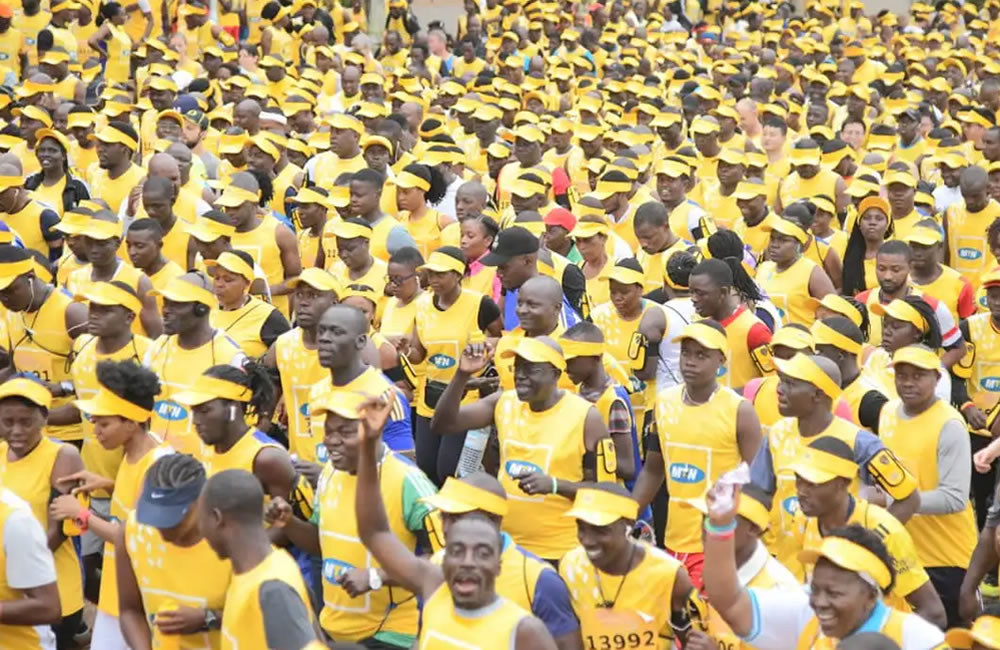
2008 MTN Kampala International Marathon Charity
The 5th edition of the MTN Kampala Marathon will take place on November 23rd 2008. In the first three editions, the proceeds from the marathon were donated to Uganda Red Cross towards the Mama Bag Appeal.
The 20 year civil war in Northern Uganda greatly undermined the public health infrastructure within the region. The Mama Bag Appeal initiative was therefore set up to provide expectant mothers living in Internally Displaced Peoples Camps (IDPs) with the basic necessities for a safe delivery. Expectant mothers were chosen because they were the most vulnerable. Over 8500 expectant mothers in Northern Uganda benefited from the proceeds of the marathon that totaled to 125 million Uganda shillings for the three years.
In 2007, peace slowly returned to the region, with many of the IDPs encouraged to go back to their homes and resettle into a normal life. The MTN Kampala Marathon donated 59 million shillings to the purchasing of a return kit to be given to families from katakwi resettling home from IDP camps. With this money, a total of 1180 kits were distributed to these families. A return kit includes farming implements, seeds, a mosquito net, among many other things.
This year, proceeds from the MTN Kampala Marathon will once again go towards purchasing return kits for families resettling in their homes within the areas of Karamoja, Kitgum, Amuria and Katakwi. The Marathon hopes to be able to purchase 2000 return kits, the cost of which is estimated at 100 million.
We cannot reverse history, but we can shape the future. Togteher we can make a difference.
MTN Kampala Marathon 2008. Run for fun, Run for life.
The marathon legend
In 490 BC, the Greeks defeated the Persians in fierce battle at a place called Marathon; In order to deliver the news of the great victory they sent a runner Pheidippides to Athens to announce the victory. He ran over a distance of roughly 42.83 Km, shortly upon arrival and delivering the good news, “Rejoice! We conquer,” he dropped dead.
Subsequently, when the first modern Olympics were held in Athens in 1896, a race was organised over the same course that Pheidippides used and thus named “The Marathon race”.
The early Olympic Games ran the Marathon over varying distances and it wasn’t till the Paris Summer games of 1924, that the standard distance of 42.195 Km was adopted and used to date.
Marathons in Uganda
The earliest marathon races held in Uganda were run in the 1920s and were organized by Officers of the Kings African Rifles in order to improve the fitness levels of the soldiers, as a result of this one of the first Ugandan Marathon routes ran between Kampala and Bombo Military Barracks.
In the subsequent years in the 50’s and 60’s when running became a popular and professional sport periodic national events began to take root and flourish. Marathons were held in Jinja, Entebbe , Lira, Arua, Mbarara and Moroto.
Unfortunately in the turbulent years from 1972 to 1987 when there was widespread persecution and disorder, organising marathons let alone any form of road-race became an impossibility.
It wasn’t till the late 80’s and the early 90’s when relative peace returned to the country that competitive road races including Marathons were organized once again. However having spent such a long period without hosting regular marathons. Local organizers faced great challenges, Sponsors were skeptical, participants limited in number and the general public uninterested.
Still through the efforts of a few committed individuals and the support of athletics officials a sprinkling of events were held in the late 80 to mid 90’s most notable amongst these was the 1991 British Airways Marathon which was the first comprehensively organized and sponsored Kampala Marathon.
In the subsequent years the Marathon reappeared as an event in the UAAF national athletics calendar both as a full 42 km event and a half marathon, however due to a lack of funds and the intensive nature of a marathon, the races were often cancelled or held under the most Spartan of conditions.
In 2004 MTN Uganda decided to widen its sports sponsorship programme. Athletics was one of the sports chosen; this was due to its wide reaching appeal and the abundance of natural running talent available. In choosing an event that would signify the intent that MTN had for athletics a decision was taken to sponsor an Inaugural Kampala Marathon. The response to this event surpassed all expectations and the inaugural MTN Kampala Marathon in 2004 drew over 1264 participants both local and international.
The actual race was won by local track star Joseph Nsubuga (fittingly a soldier) who clocked a winning time of 2:18:21 while the women’s race was won by Margaret Nakintu in a time of 3:07:17. These times though considered slow by international standards must be considered in their context, the route in Kampala “the city of seven hills” is one of the most challenging in the world.
The second edition of the MTN Kampala Marathon was dominated by Kenyans the Men’s race was won by Busienei Wilson Kipkemei who led a Kenyan clean sweep of the first three places, the time itself was disappointingly slow 2 hours 31 minutes 31 seconds, well below the previous years best set by Joseph Nsubuga.
The women’s race once again confirmed the dominance of Margeret Nakinti on the Ugandan women’s marathon scene she successfully defended her title in a time of 2:48:18. Unfortunately she will not be able to defend her title in 2006 having won the event twice and long dominated the local distance running scene she secured a sports scholarship and is now permanently based in the US.
Read More
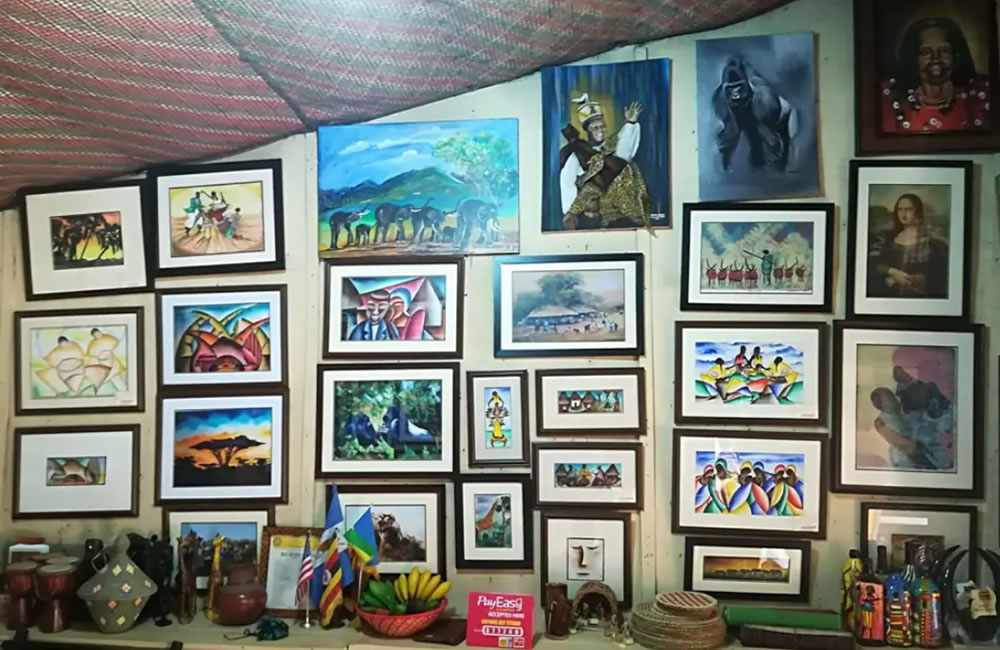
Nnyanzi Art: Visual Feast From The Pearl Of Africa
Two artists who share the same heritage chose to share their artistic creations with the community and visitors of Whitstable from May 11th to 24th, 2005 at the Horsebridge Arts and Community Centre.
The exhibit, which attracted more than 800 visitors, showcased Nansubuga Kolawole’s poems, which successfully illustrate Nuwa Wamala Nnyanzi’s most recent works of art.
Nansubuga, is married with two children, has a bachelor’s degree in Law from the University of Bristol, UK and a Masters in Science in Development Studies. Nansubuga is a new entrant in the field of art. Nnyanzi is a veteran of twenty-six years. Nnyanzi a self-taught visual arts practitioner recently graduated with a first class MA Design (Professional Practice) degree from Middlesex University, UK.
Nansubuga grew up appreciating art and later on became a collector. Nnyanzi’s art so inspired her that not only does she collect it but promotes it too and is responsible for organizing the exhibitions. Nansubuga said that as a compliment to her cousin’s illustrious career spanning a quarter of a century, she decided to put her feelings and interpretation in poem form.
One of her poems; ‘I Will Be Here For You’ appropriately hang next to Nnyanzi’s ‘You Are My World’, a batik painting portraying a mother holding her child in a loving and tender manner. Nnyanzi’s use of mono colour and simple lines to capture motion and emotion is clearly manifest in this piece. So is Nansubuga’s choice and arrangement of words.
Another example of the successful collaboration between the two cousins is demonstrated in Nnyanzi’s ‘Gender Issues’, in which a woman clad in busuuti (one of Ugandan women’s traditional dress) is portrayed writing on a banner words, which read; ‘Empower Women.’ The same banner on the left hand side; is supported by a woman clad in munagiro (yet another Ugandan women’s traditional attire). While on the right side is a man pounding food, a role that is traditionally dominated by women. The man’s mortar is raised and at the top it serves as a flag post for the banner.
Nnyanzi’s legendary commitment to his faith also manifests itself in some pieces such as; ‘The Pentecost’, ‘Taking Care of Humanity’, ‘The Trinity’, while his pan-Africanism is vivid in: ‘African Defence Symbols’ and ‘African Connection.’
Although a pan-Africanist, Nnyanzi without apologies is proud of his roots in the centuries old kingdoms of Bunyoro Kitara and Buganda located in the great lakes region. It comes out clearly in the newly created pieces such as; ‘Mujaguzo’, ‘Emotionally Engaged’, ‘Rhythm and Emotion’, and ‘The Joy of Life.’ The two also addressed other areas in the show, which included responsible parenthood, love, royalty, effects of war, and challenges the youth face.
The art exhibit attracted a cross section of people. Basing on the comments recorded in the guest book and exchanges between guests and artists; viewers seem to have been emotionally touched. Among the visitors were children, youth, middle aged, and senior citizens. The majority of them especially those who were seeing that type of art for the first time were impressed by the application of colour, mastery of depicting motion and emotion, the choice and arrangements of words and titles.
The first weekend attracted over four hundred visitors from different parts of the world because Whitstable is a very popular tourist destination. The majority of them had no idea where Uganda is located on the map. With the help of a map and a lot of story telling they were more informed by the time they left.
A six year old girl on seeing the piece titled ‘The Pentecost’, which portrays the Apostles raising their arms to receive the Holy Spirit, while emulating the gesture she broke into a song; YMCA. It is clear that the gesture reminded her of The Village People’s song YMCA and the video clip, which shows people singing and raising their arms to form letters that make up YMCA. That was her personal interpretation.
Artists who were exhibiting in the neighboring gallery also expressed their fascination with the art they were seeing for the first time. One of them, a retired swimming pool designer described the art as; ‘Very African on the outlook yet with many key elements of European art’. He added; ‘It is very tranquilizing’.
An eighty year old woman who was the first to acquire a piece from the collection turned her bag inside out in search of money but could only come up with less than what was necessary. But she was not to be outdone. She rushed home to collect the balance. Luckily for her, on her way home she met with her husband who gave her the entire amount. As she was trying to explain to him why she desperately needed to get the art, he just waived her off saying: ‘seeing how excited you are about it. I will like it too. So go ahead and get it darling’.
Art students from the University of Canterbury also found the art show very useful in terms of exposure to new forms of art. They also saw it as a valuable resource material for their projects. A teacher of a school for disabled children booked a day to bring his students to the exhibit because he felt that they were likely to benefit from it in terms of visual entertainment and emotional therapy.
A husband to one of the artists exhibiting in the neighboring gallery described Nnyanzi’s art as graphic, colourful and very moving. He said that if he were to buy he would go for ‘At Peace With Each Other’ because of the shapes and forms, which when put together bring out how the woman and man in the piece feel about each other. The woman’s hand tenderly and possessively holds the man’s head close to her bosom. The man obligingly, with eyes closed rests peacefully and seems to be enjoying every moment of it. And the woman with her eyes closed and a faint yet revealing smile on her lips says it all.
Artist Olive Powel’s husband, a retired designer of swimming pools, on walking into the exhibition hall said he felt like collapsing in a rocking chair in front of the art pieces and taking in everything. He described the works of art as soothing and musical. He suggested to his wife that next time she felt like giving him a present she would be well appreciated if she bought him; ‘At Peace With Each Other.’
John Winston Jenkins, a trained draughtsman and visualiser who had worked for a big landscaping firm and later established his own consultancy in the swimming pool industry found Nnyanzi’s art refreshing.
Michael Stringer aged 71, retired designer and painter, and a remarkable storyteller described Nnyanzi’s art as very African and detected some resemblance with the French artist whom he believes influenced Pablo Picasso. Unfortunately he could not recall his name. But he promised to go and find out from the library where he had seen it. With his walking stick he slowly made his way to the library and was back later with the name and an interesting story to tell. The name of the artist happened to be Ferdinand Leger. He talked about a book on the lives of Picasso, Braque and another famous French artist whose art Picasso did not want to compare with his. But on the author’s insistence, at the breakfast table Picasso leaned forward, both hands on his cheeks and blurted out ‘That bastard can paint.’
The most popular pieces in the exhibit were: ‘At Peace With Oneself’ and ‘Outdoing Each Other.’
The work reminded Peter Hackford of Egypt where he had come across the quote’ I hold you in my heart like a reed in the arms of the wind’ To him the curves and embrace were a show of love.
All in all the exhibit was successful in terms of exposure and there is need for a more exhibits in future to make the people more familiar with our art. As a result more people may develop a taste for our art to the level of acquiring it. With the policy of fair trade being promoted by European countries it is likely that the visual arts industry will benefit greatly from the move. Besides it is high time Uganda contributed to global culture instead of just being consumers.
All the new pieces on show plus others, which are yet to be revealed to the public will soon be posted on; www.nnyanziart.com
Read More